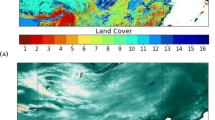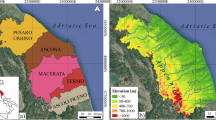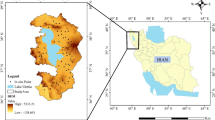Abstract
Radar satellite imagery has been widely used to obtain soil moisture (SM) estimates of high accuracy. However, obtaining the best accuracy of SM estimates requires investigating the contribution of vegetation canopy to the accuracy of retrieved SM. We used the Integral Equation Model (IEM) coupled with the Water Cloud Model (WCM) (herein referred to as the IWCM) to estimate surface SM using radar and multi-spectral images. Accordingly, Sentinel-1 and Sentinel-2 images corresponding to calibration (2017) and validation (2016) periods were used to obtain VV-polarized radar data (where radar transmits and receives vertical polarization), Leaf Area Index, and Normalized Difference Vegetation Index at the SM measurement stations. SM measurements from eleven stations in the Walnut Gulch watershed, USA, were used as in situ data. Investigating the relationship between the simulation error on various variables revealed a dependence of error on precipitation received on the day before soil moisture measurement was carried out. Next, two data-driven models (DDMs), i.e., Support Vector Machine (SVM) and the Regression Tree (RT), were used to obtain SM estimates at stations using radar signal and vegetation indices as their input features. Accordingly, the RT model showed the best performance with validation error of 0.071 m3/m3 and 0.074 m3/m3 for the LAI and NDVI-based models, respectively. Based on the RT results, precipitation of the previous day, followed by the Julian date had the highest values of importance in predicting the the soil moisture. The RT model was consequently used to calculate regionalized estimates for the watershed due to its higher accuracy in estimating SM in the measurement stations. The results indicated the feasibility of using DDMs to obtain regionalized surface SM measurements at the watershed scale.









Similar content being viewed by others
Data availability
The datasets generated during and/or analyzed during the current study are available from the first author upon reasonable request.
References
Alexakis DD, Mexis F-DK, Vozinaki A-EK, Daliakopoulos IN, Tsanis IK (2017) Soil moisture content estimation based on Sentinel-1 and auxiliary earth observation products. A hydrological approach. Sensors 17(6):1455
Álvarez-Mozos J, Casalí J, González-Audícana M, Verhoest NEC (2006) Assessment of the operational applicability of RADARSAT-1 data for surface soil moisture estimation. IEEE Trans Geosci Remote Sens 44(4):913–924
Attema EPW, Ulaby FT (1978) Vegetation modeled as a water cloud. Radio Sci 13(2):357–364
Awad M, Khanna R (2015) Efficient learning machines: theories, concepts, and applications for engineers and system designers. Springer Nature, Berlin
Baghdadi N, Gherboudj I, Zribi M, Sahebi M, King C, Bonn F (2004) Semi-empirical calibration of the IEM backscattering model using radar images and moisture and roughness field measurements. Int J Remote Sens 25(18):3593–3623
Baghdadi N, Cerdan O, Zribi M, Auzet V, Darboux F, El Hajj M, Kheir RB (2008) Operational performance of current synthetic aperture radar sensors in mapping soil surface characteristics in agricultural environments: application to hydrological and erosion modelling. Hydrol Process 22(1):9–20
Baghdadi N, Camus P, Beaugendre N, Issa OM, Zribi M, Desprats JF, Rajot JL, Abdallah C, Sannier C (2011) Estimating surface soil moisture from TerraSAR-X data over two small catchments in the Sahelian Part of Western Niger. Remote Sensing 3(6):1266–1283
Baghdadi N, Aubert M, Zribi M (2012) Use of TerraSAR-X data to retrieve soil moisture over bare soil agricultural fields. IEEE Geosci Remote Sens Lett 9(3):512–516
Baghdadi N, El Hajj M, Zribi M, Bousbih S (2017) Calibration of the water cloud model at C-band for winter crop fields and grasslands. Remote Sens 9(9):969
Bai X, He B, Li X (2015) Optimum surface roughness to parameterize advanced integral equation model for soil moisture retrieval in prairie area using Radarsat-2 data. IEEE Trans Geosci Remote Sens 54(4):2437–2449
Bai X, He B, Li X, Zeng J, Wang X, Wang Z, Zeng Y, Su Z (2017) First assessment of Sentinel-1A data for surface soil moisture estimations using a coupled water cloud model and advanced integral equation model over the Tibetan Plateau. Remote Sensing 9(7):714
Bao Y, Lin L, Wu S, Deng KAK, Petropoulos GP (2018) Surface soil moisture retrievals over partially vegetated areas from the synergy of Sentinel-1 and Landsat 8 data using a modified water-cloud model. Int J Appl Earth Obs Geoinf 72:76–85
Becker R, Gebremichael M, Märker M (2018) Impact of soil surface and subsurface properties on soil saturated hydraulic conductivity in the semi-arid Walnut Gulch Experimental Watershed, Arizona, USA. Geoderma 322:112–120
Brocca L, Morbidelli R, Melone F, Moramarco T (2007) Soil moisture spatial variability in experimental areas of central Italy. J Hydrol 333(2–4):356–373
Bryant R, Moran MS, Thoma DP, Collins CDH, Skirvin S, Rahman M, Slocum K, Starks P, Bosch D, Dugo MPG (2007) Measuring surface roughness height to parameterize radar backscatter models for retrieval of surface soil moisture. IEEE Geosci Remote Sens Lett 4(1):137–141
Cortes C, Vapnik V (1995) Support-vector networks. Mach Learn 20(3):273–297
Crow WT, Berg AA, Cosh MH, Loew A, Mohanty BP, Panciera R, de Rosnay P, Ryu D, Walker JP (2012) Upscaling sparse ground-based soil moisture observations for the validation of coarse-resolution satellite soil moisture products. Rev Geophys 50(2):RG2002
Dobson MC, Ulaby FT, Hallikainen MT, El-Rayes MA (1985) Microwave dielectric behavior of wet soil-part II: dielectric mixing models. IEEE Trans Geosci Remote Sens 1:35–46
Dubois PC, Van Zyl J, Engman T (1995) Measuring soil moisture with imaging radars. IEEE Trans Geosci Remote Sens 33(4):915–926
El Hajj M, Baghdadi N, Zribi M, Bazzi H (2017) Synergic use of Sentinel-1 and Sentinel-2 images for operational soil moisture mapping at high spatial resolution over agricultural areas. Remote Sens 9(12):1292
Famiglietti J, Wood EF (1994) Multiscale modeling of spatially variable water and energy balance processes. Water Resour Res 30(11):3061–3078
Fang K, Shen C (2020) Near-real-time forecast of satellite-based soil moisture using long short-term memory with an adaptive data integration kernel. J Hydrometeorol 21(3):399–413
Fang K, Shen C, Kifer D, Yang X (2017) Prolongation of SMAP to spatiotemporally seamless coverage of continental US using a deep learning neural network. Geophys Res Lett 44(21):11–030
Filippucci P, Brocca L, Massari C, Saltalippi C, Wagner W, Tarpanelli A (2021) Toward a self-calibrated and independent SM2RAIN rainfall product. J Hydrol 603:126837
Fung AK, Chen K-S (2004) An update on the IEM surface backscattering model. IEEE Geosci Remote Sens Lett 1(2):75–77
Fung AK, Li Z, Chen K-S (1992) Backscattering from a randomly rough dielectric surface. IEEE Trans Geosci Remote Sens 30(2):356–369
Fung AK, Chen K-S, Chen KS (2010) Microwave scattering and emission models for users. Artech house, Norwood
Gao Q, Zribi M, Escorihuela M, Baghdadi N (2017) Synergetic use of Sentinel-1 and Sentinel-2 data for soil moisture mapping at 100 m resolution. Sensors 17(9):1966
Gorrab A, Zribi M, Baghdadi N, Lili-Chabaane Z, Mougenot B (2014) Multi-frequency analysis of soil moisture vertical heterogeneity effect on radar backscatter. 2014 1st International Conference on Advanced Technologies for Signal and Image Processing (ATSIP), pp 379–384
Greifeneder F, Notarnicola C, Wagner W (2021) A Machine learning-based approach for surface soil moisture estimations with google earth engine. Remote Sens 13(11):2099
Hachani A, Ouessar M, Paloscia S, Santi E, Pettinato S (2019) Soil moisture retrieval from Sentinel-1 acquisitions in an arid environment in Tunisia: application of artificial neural networks techniques. Int J Remote Sens 40(24):9159–9180
Han Y, Bai X, Shao W, Wang J (2020) Retrieval of soil moisture by integrating Sentinel-1A and MODIS data over agricultural fields. Water 12(6):1726
Hastie T, Tibshirani R, Friedman JH, Friedman JH (2009) The elements of statistical learning: data mining, inference, and prediction, vol 2. Springer, New York
He B, Xing M, Bai X (2014) A synergistic methodology for soil moisture estimation in an alpine prairie using radar and optical satellite data. Remote Sens 6(11):10966–10985
Holah N, Baghdadi N, Zribi M, Bruand A, King C (2005) Potential of ASAR/ENVISAT for the characterization of soil surface parameters over bare agricultural fields. Remote Sens Environ 96(1):78–86
Jackson TJ (2002) Remote sensing of soil moisture: Implications for groundwater recharge. Hydrogeol J 10(1):40–51
Kerr YH (2007) Soil moisture from space: where are we? Hydrogeol J 15(1):117–120
Kumar K, Suryanarayana Rao HP, Arora MK (2015) Study of water cloud model vegetation descriptors in estimating soil moisture in Solani catchment. Hydrol Process 29(9):2137–2148
Kumar A, Ramsankaran R, Brocca L, Munoz-Arriola F (2019) A machine learning approach for improving near-real-time satellite-based rainfall estimates by integrating soil moisture. Remote Sens 11(19):2221
Li L, Dai Y, Shangguan W, Wei N, Wei Z, Gupta S (2022) Multistep forecasting of soil moisture using spatiotemporal deep encoder–decoder networks. J Hydrometeorol 23(3):337–350
Liu Y, Qian J, Yue H (2020) Combined Sentinel-1A with Sentinel-2A to estimate soil moisture in farmland. IEEE J Sel Top Appl Earth Obs Remote Sens 14:1292–1310
Mueller-Wilm U, Devignot O, Pessiot L (2017) S2 MPC Sen2Cor configuration and user manual (No. S2-PDGS-MPC-L2A-SUM-V2.8). http://step.esa.int/thirdparties/sen2cor/2.8.0/docs/S2-PDGS-MPC-L2A-SUM-V2.8.pdf
Nearing GS, Gupta HV (2015) The quantity and quality of information in hydrologic models. Water Resour Res 51(1):524–538
Oh Y (2004) Quantitative retrieval of soil moisture content and surface roughness from multipolarized radar observations of bare soil surfaces. IEEE Trans Geosci Remote Sens 42(3):596–601
Peng J, Loew A, Merlin O, Verhoest NEC (2017) A review of spatial downscaling of satellite remotely sensed soil moisture. Rev Geophys 55(2):341–366
Petropoulos GP, Ireland G, Barrett B (2015) Surface soil moisture retrievals from remote sensing: current status, products & future trends. Phys Chem Earth Parts A/B/C 83–84:36–56. https://doi.org/10.1016/j.pce.2015.02.009
Qiu J, Crow WT, Wagner W, Zhao T (2019) Effect of vegetation index choice on soil moisture retrievals via the synergistic use of synthetic aperture radar and optical remote sensing. Int J Appl Earth Obs Geoinf 80:47–57
Rahman MM, Moran MS, Thoma DP, Bryant R, Sano EE, Holifield Collins CD, Skirvin S, Kershner C, Orr BJ (2007) A derivation of roughness correlation length for parameterizing radar backscatter models. Int J Remote Sens 28(18):3995–4012
Robock A, Vinnikov KY, Srinivasan G, Entin JK, Hollinger SE, Speranskaya NA, Liu S, Namkhai A (2000) The global soil moisture data bank. Bull Am Meteor Soc 81(6):1281–1300
Seneviratne SI, Corti T, Davin EL, Hirschi M, Jaeger EB, Lehner I, Orlowsky B, Teuling AJ (2010) Investigating soil moisture–climate interactions in a changing climate: a review. Earth Sci Rev 99(3–4):125–161
Shen C (2018) A transdisciplinary review of deep learning research and its relevance for water resources scientists. Water Resour Res 54(11):8558–8593
SNAP - ESA Sentinel Application Platform v6.0 (2018)- http://step.esa.int
Solomatine DP, Shrestha DL (2009) A novel method to estimate model uncertainty using machine learning techniques. Water Resour Res 45(12):W00B11. https://doi.org/10.1029/2008WR006839
Topp GC, Reynolds WD (1998) Time domain reflectometry: a seminal technique for measuring mass and energy in soil. Soil Till Res 47(1–2):125–132
Topp GC, Davis JL, Annan AP (1980) Electromagnetic determination of soil water content: measurements in coaxial transmission lines. Water Resour Res 16(3):574–582
Tucker CJ (1979) Red and photographic infrared linear combinations for monitoring vegetation. Remote Sens Environ 8(2):127–150
Tyralis H, Papacharalampous G, Langousis A (2019) A brief review of random forests for water scientists and practitioners and their recent history in water resources. Water 11(5):910
Ulaby FT, Moore RK, Fung AK (1982) Microwave remote sensing: active and passive. Volume 2-radar remote sensing and surface scattering and emission theory. Artech House, London
Verhoest N, Lievens H, Wagner W, Álvarez-Mozos J, Moran M, Mattia F (2008) On the soil roughness parameterization problem in soil moisture retrieval of bare surfaces from synthetic aperture radar. Sensors 8(7):4213–4248
Wang JR, Schmugge TJ (1980) An empirical model for the complex dielectric permittivity of soils as a function of water content. IEEE Trans Geosci Remote Sens 4:288–295
Wang L, He B, Bai X, Xing M (2019) Assessment of different vegetation parameters for parameterizing the coupled water cloud model and advanced integral equation model for soil moisture retrieval using time series Sentinel-1A data. Photogramm Eng Remote Sens 85(1):43–54
Watson DJ (1947) Comparative physiological studies on the growth of field crops: I. Variation in net assimilation rate and leaf area between species and varieties, and within and between years. Ann Bot 11(41):41–76
Zhang L, Zhang Z, Xue Z, Li H (2021) Sensitive feature evaluation for soil moisture retrieval based on multi-source remote sensing data with few in situ measurements: a case study of the continental US. Water 13(15):2003
Author information
Authors and Affiliations
Contributions
Conceptualization: Banafsheh Zahraie, Mohsen Nasseri, Methodology: Neda Dolatabadi, Banafsheh Zahraie, Mohsen Nasseri; Formal analysis and investigation: Neda Dolatabadi; Writing - original draft preparation: Neda Dolatabadi; Writing - review and editing: Banafsheh Zahraie, Mohsen Nasseri; Supervision: Mohsen Nasseri, Banafsheh Zahraie.
Corresponding author
Ethics declarations
Competing interests
The authors declare no competing interests.
Additional information
Communicated by: H. Babaie
Publisher's note
Springer Nature remains neutral with regard to jurisdictional claims in published maps and institutional affiliations.
Appendices
Appendix 1
Appendix 2
The transition reflection coefficient (\({R}_{\mathrm{tv}}\)) can be computed as:
where \({R}_{\mathrm{vo}}\) is the vertical reflection coefficient at the specular angle (zero incidence angle) and other variables are similar to those in Eqs. 6 to 13. If the exponential function is selected for the ACF, the surface spectrum function takes the following form (Fung et al. 2010).
where \(k\), \(l\), and \(\theta\) are wave number, surface correlation length, and incidence angle, respectively.
Rights and permissions
Springer Nature or its licensor (e.g. a society or other partner) holds exclusive rights to this article under a publishing agreement with the author(s) or other rightsholder(s); author self-archiving of the accepted manuscript version of this article is solely governed by the terms of such publishing agreement and applicable law.
About this article
Cite this article
Dolatabadi, N., Nasseri, M. & Zahraie, B. Comparative assessment of surface soil moisture simulations by the coupled wcm-iem vs. data-driven models using the Sentinel 1 and 2 satellite images. Earth Sci Inform 16, 1563–1584 (2023). https://doi.org/10.1007/s12145-023-00987-9
Received:
Accepted:
Published:
Issue Date:
DOI: https://doi.org/10.1007/s12145-023-00987-9






